小学英语介词汇总
- 格式:docx
- 大小:32.17 KB
- 文档页数:19
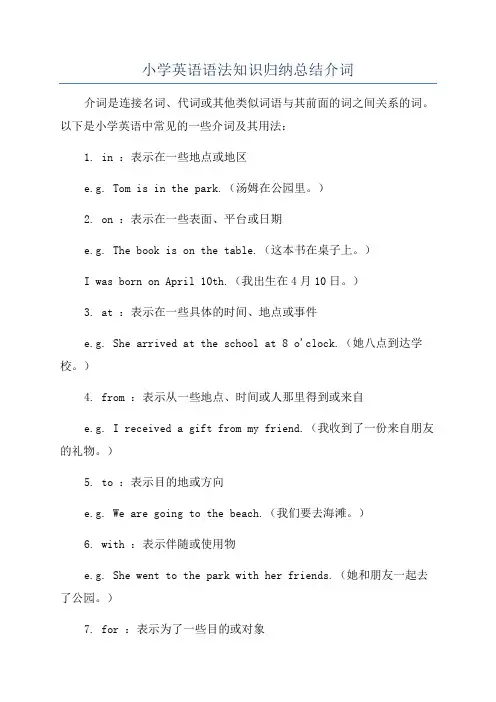
小学英语语法知识归纳总结介词介词是连接名词、代词或其他类似词语与其前面的词之间关系的词。
以下是小学英语中常见的一些介词及其用法:1. in :表示在一些地点或地区e.g. Tom is in the park.(汤姆在公园里。
)2. on :表示在一些表面、平台或日期e.g. The book is on the table.(这本书在桌子上。
)I was born on April 10th.(我出生在4月10日。
)3. at :表示在一些具体的时间、地点或事件e.g. She arrived at the school at 8 o'clock.(她八点到达学校。
)4. from :表示从一些地点、时间或人那里得到或来自e.g. I received a gift from my friend.(我收到了一份来自朋友的礼物。
)5. to :表示目的地或方向e.g. We are going to the beach.(我们要去海滩。
)6. with :表示伴随或使用物e.g. She went to the park with her friends.(她和朋友一起去了公园。
)7. for :表示为了一些目的或对象e.g. I bought a cake for my mom's birthday.(我为我妈妈的生日买了一个蛋糕。
)8. by :表示通过其中一种方式或交通工具e.g. I go to school by bus every day.(我每天坐公交车去学校。
)9. about :表示关于一些话题或主题e.g. We had a discussion about our summer vacation plans.(我们就暑假计划进行了一次讨论。
)10. to :表示直接的动作对象或方向e.g. I gave the present to my best friend.(我把礼物给了我最好的朋友。
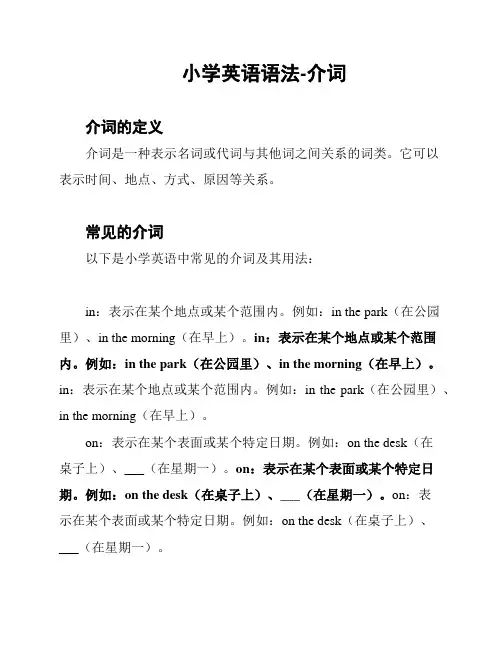
小学英语语法-介词介词的定义介词是一种表示名词或代词与其他词之间关系的词类。
它可以表示时间、地点、方式、原因等关系。
常见的介词以下是小学英语中常见的介词及其用法:in:表示在某个地点或某个范围内。
例如:in the park(在公园里)、in the morning(在早上)。
in:表示在某个地点或某个范围内。
例如:in the park(在公园里)、in the morning(在早上)。
in:表示在某个地点或某个范围内。
例如:in the park(在公园里)、in the morning(在早上)。
on:表示在某个表面或某个特定日期。
例如:on the desk(在桌子上)、___(在星期一)。
on:表示在某个表面或某个特定日期。
例如:on the desk(在桌子上)、___(在星期一)。
on:表示在某个表面或某个特定日期。
例如:on the desk(在桌子上)、___(在星期一)。
at:表示在具体的时间或某个地点。
例如:at 7 o'clock(在7点)、___(在学校)。
at:表示在具体的时间或某个地点。
例如:at 7 o'clock(在7点)、___(在学校)。
at:表示在具体的时间或某个地点。
例如:at 7 o'clock(在7点)、___(在学校)。
to:表示向某个地点或某个目标。
例如:go to the supermarket (去超市)。
to:表示向某个地点或某个目标。
例如:go to the supermarket(去超市)。
to:表示向某个地点或某个目标。
例如:go to the supermarket(去超市)。
from:表示从某个地点或某个时间开始。
例如:___(从星期一到星期五)。
from:表示从某个地点或某个时间开始。
例如:___(从星期一到星期五)。
from:表示从某个地点或某个时间开始。
例如:___(从星期一到星期五)。
by:表示通过某种方式或某个工具。
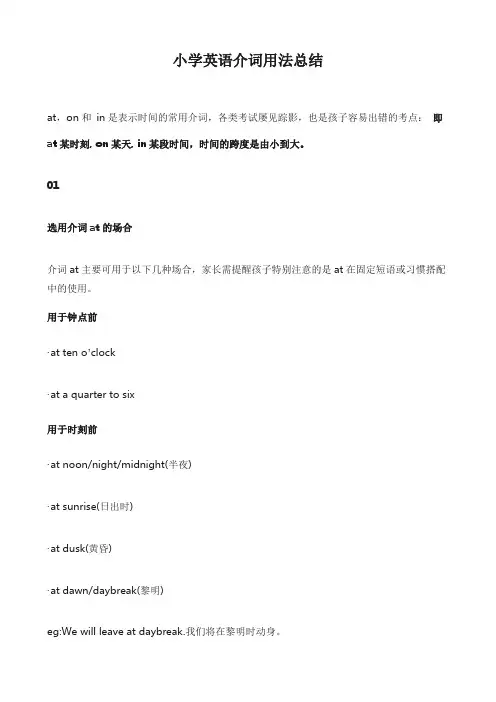
小学英语介词用法总结at,on和in是表示时间的常用介词,各类考试屡见踪影,也是孩子容易出错的考点:即at某时刻, on某天, in某段时间,时间的跨度是由小到大。
01选用介词at的场合介词at主要可用于以下几种场合,家长需提醒孩子特别注意的是at在固定短语或习惯搭配中的使用。
用于钟点前·at ten o’clock·at a quarter to six用于时刻前·at noon/night/midnight(半夜)·at sunrise(日出时)·at dusk(黄昏)·at dawn/daybreak(黎明)eg:We will leave at daybreak.我们将在黎明时动身。
用于表示进餐时间。
如:·at breakfast/lunch/supper(在早餐时/午餐时/晚餐时) eg:He drinks tea at breakfast.他在早餐时饮茶。
用于表示年龄时。
如:·at 14(= at the age of14在14岁)eg: He left home at the age of 16.他十六岁离开了家。
用于一些固定短语或习惯搭配中。
如:·at Christmas·at New Year·at Thanksgiving (感恩节)·at the beginning/end of last month·at the moment/ at that time·at this time of day·at a bad time of year·at first (起初)·at last (终于)02选用介词on的场合用于星期、日期(包括该天的各部分)前·on Sundays/weekdays·on Monday morning / afternoon / eveningeg:I'm flying home on Sunday afternoon. 我星期四下午乘飞机回家。
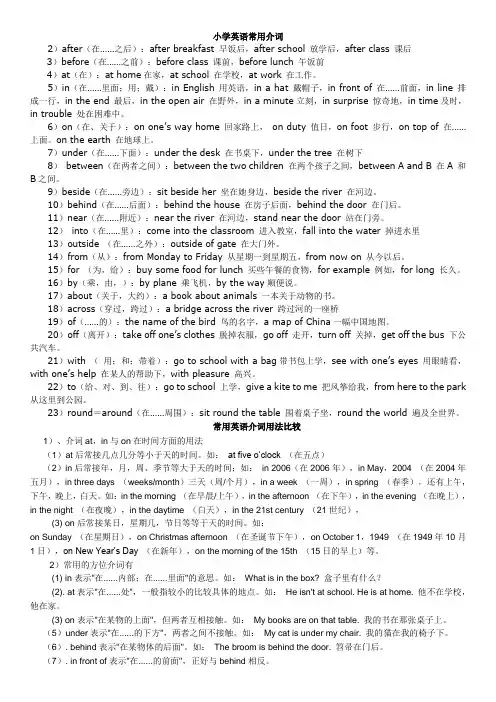
小学英语常用介词2)after(在……之后):after breakfast 早饭后,after school 放学后,after class 课后3)before(在……之前):before class 课前,before lunch 午饭前4)at(在):at home在家,at school 在学校,at work 在工作。
5)in(在……里面;用;戴):in English 用英语,in a hat 戴帽子,in front of 在……前面,in line 排成一行,in the end 最后,in the open air 在野外,in a minute立刻,in surprise 惊奇地,in time及时,in trouble 处在困难中。
6)on(在、关于):on one’s way home 回家路上,on duty 值日,on foot 步行,on top of 在……上面。
on the earth 在地球上。
7)under(在……下面):under the desk 在书桌下,under the tree 在树下8)between(在两者之间):between the two children 在两个孩子之间,between A and B 在A 和B之间。
9)beside(在……旁边):sit beside her 坐在她身边,beside the river 在河边。
10)behind(在……后面):behind the house 在房子后面,behind the door 在门后。
11)near(在……附近):near the river 在河边,stand near the door 站在门旁。
12)into(在……里):come into the classroom 进入教室,fall into the water 掉进水里13)outside (在……之外):outside of gate 在大门外。
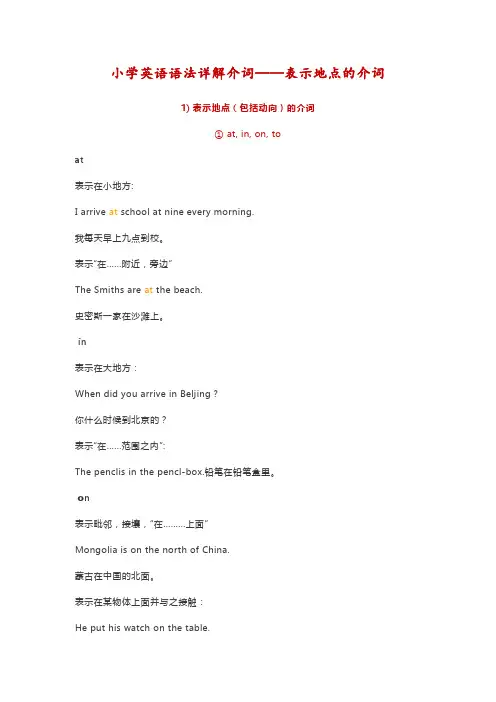
小学英语语法详解介词——表示地点的介词1) 表示地点(包括动向)的介词① at, in, on, toat表示在小地方:I arrive at school at nine every morning.我每天早上九点到校。
表示“在……附近,旁边”The Smiths are at the beach.史密斯一家在沙滩上。
in表示在大地方:When did you arrive in Beljing?你什么时候到北京的?表示“在……范围之内”:The penclis in the pencl-box.铅笔在铅笔盒里。
on表示毗邻,接壤,“在………上面”Mongolia is on the north of China.蒙古在中国的北面。
表示在某物体上面并与之接触:He put his watch on the table.他把手表放桌上。
to表示“在……范围外”不强调是否接壤:或“到……”:Japan is to the east of China.日本在中国的东面。
②above, overabove指“在……上方”,不强调是否垂直,与below相对:The bird is flying above my head.鸟儿在我头顶上飞过。
over指垂直的上方,与under相对,over有覆盖的含义在里面:There is a bridge over the river.江上有座桥。
③below, underunder表示“在……正下方”:There is a cat under the table.桌子下面有只猫。
below表示“在……下方”,不一定在正下方:Please write your name below the line.请在线的下方写上您的名字。
④in front of, in the front ofin front of“在……前面”,指甲物在乙物之前,两者互不包括:其反义词是behind (在……的后面):There are some flowers in front of the house.房子前面有些花卉。
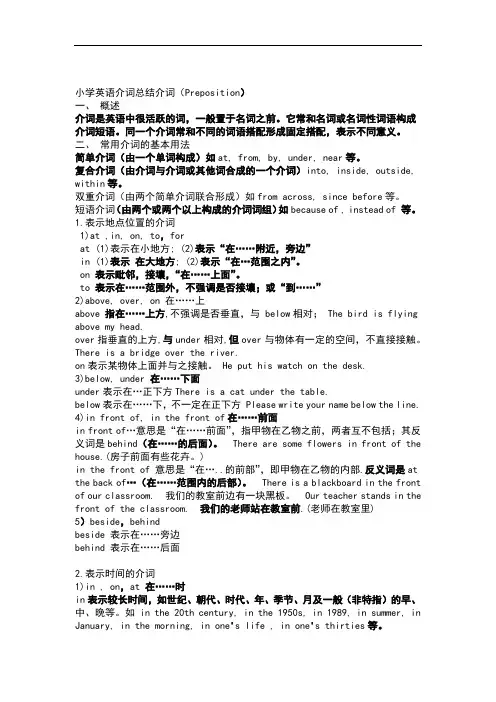
小学英语介词总结介词(Preposition)一、概述介词是英语中很活跃的词,一般置于名词之前。
它常和名词或名词性词语构成介词短语。
同一个介词常和不同的词语搭配形成固定搭配,表示不同意义。
二、常用介词的基本用法简单介词(由一个单词构成)如at, from, by, under, near等。
复合介词(由介词与介词或其他词合成的一个介词)into, inside, outside, within等。
双重介词(由两个简单介词联合形成)如from across, since before等。
短语介词(由两个或两个以上构成的介词词组)如because of , instead of 等。
1.表示地点位置的介词1)at ,in, on, to,forat (1)表示在小地方; (2)表示“在……附近,旁边”in (1)表示在大地方; (2)表示“在…范围之内”。
on 表示毗邻,接壤,“在……上面”。
to 表示在……范围外,不强调是否接壤;或“到……”2)above, over, on 在……上above 指在……上方,不强调是否垂直,与 below相对; The bird is flying above my head.over指垂直的上方,与under相对,但over与物体有一定的空间,不直接接触。
There is a bridge over the river.on表示某物体上面并与之接触。
He put his watch on the desk.3)below, under 在……下面under表示在…正下方There is a cat under the table.below表示在……下,不一定在正下方 Please write your name below the line.4)in front of, in the front of在……前面in front of…意思是“在……前面”,指甲物在乙物之前,两者互不包括;其反义词是behind(在……的后面)。
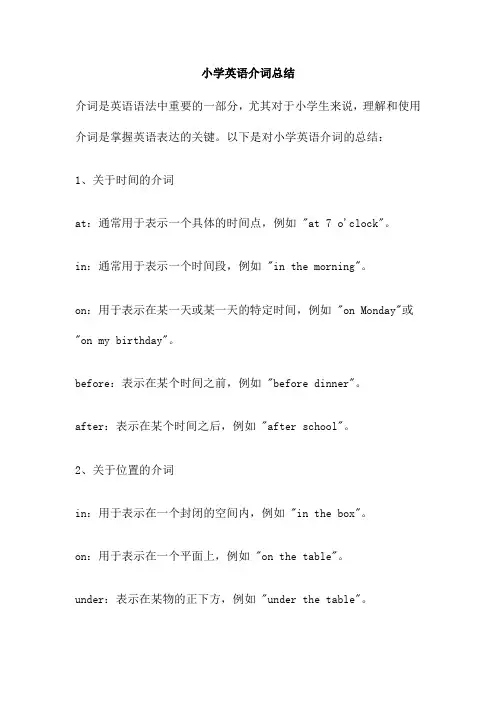
小学英语介词总结介词是英语语法中重要的一部分,尤其对于小学生来说,理解和使用介词是掌握英语表达的关键。
以下是对小学英语介词的总结:1、关于时间的介词at:通常用于表示一个具体的时间点,例如 "at 7 o'clock"。
in:通常用于表示一个时间段,例如 "in the morning"。
on:用于表示在某一天或某一天的特定时间,例如 "on Monday"或"on my birthday"。
before:表示在某个时间之前,例如 "before dinner"。
after:表示在某个时间之后,例如 "after school"。
2、关于位置的介词in:用于表示在一个封闭的空间内,例如 "in the box"。
on:用于表示在一个平面上,例如 "on the table"。
under:表示在某物的正下方,例如 "under the table"。
above:表示在某物的上方,但是不一定是正上方,例如 "above the table"。
beside:表示在某物的旁边,例如 "beside the book"。
3、关于方向的介词to:用于表示朝向某个方向或地点,例如 "go to school"。
from:用于表示从一个地方或位置到另一个地方或位置,例如 "come from school"。
towards:表示朝向某个方向或地点,但是不一定到达那里,例如"walk towards the park"。
4、关于原因的介词because:用于表示原因或理由,例如 "I am late because I missed the bus"。
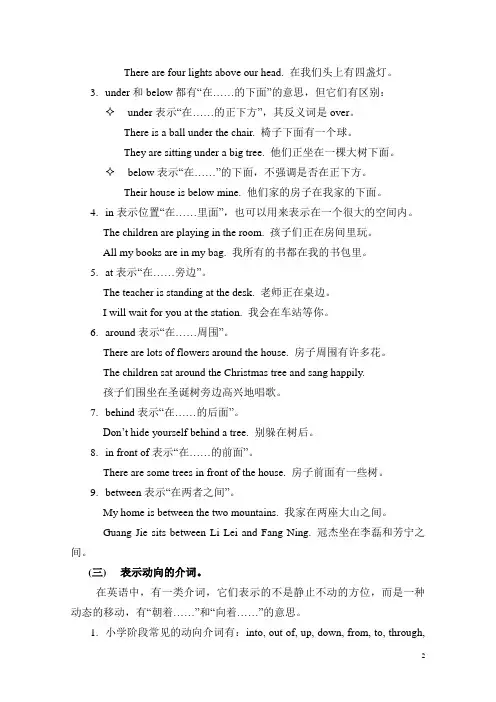
常见介词及用法(一)表示时间的介词1.英语里最常见的时间介词有:at, in, on, before, after和from。
2.at , in和on这三个词都表示时间。
✧at主要指具体的钟点:at half past eight 在八点半✧in一般指某一段时间:in January 在一月份✧on指具体在某一天:on Monday 在星期一3.before和after表示时间的先后顺序。
✧before表示“在……之前”。
You should wash your hands before eating. 吃饭前你应该洗手。
✧after表示“在……之后”。
They often play basketball after dinner. 他们放学后经常打篮球。
4.from作时间介词含有“从……开始”的意思,常和to连用,组成“from…to…”的结构,表示“从……到……”的意思。
We go to school from Monday to Friday. 我们从周一到周五上学。
(二)表示方位的介词,也就是表示位置和地点的介词。
1.小学阶段常见的方位介词有:on, in, at, under, over, above, below, about,around, between等。
2.on, over和above这三个词都有“在……上面”的意思,但它们所表示的方位还是有些不同。
✧on表示两个物体的表面相互接触。
如:There is a book on the desk. 桌上有一本书。
The boy is sleeping on the desk. 那个孩子睡在地上。
✧over表示“在……的正上方”,两个物体表面没有接触。
如:There is a light bulb over my head. 在我头顶上有一个灯泡。
✧above表示两个物体中一个在另一个的上方,如:The plane is flying above the clouds. 飞机上云层上飞行。
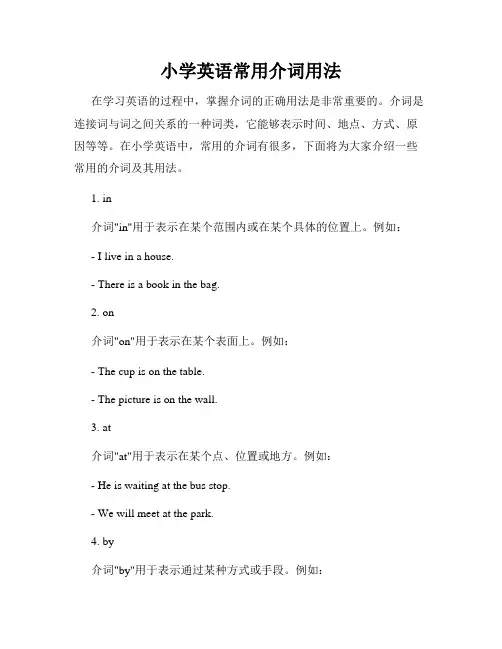
小学英语常用介词用法在学习英语的过程中,掌握介词的正确用法是非常重要的。
介词是连接词与词之间关系的一种词类,它能够表示时间、地点、方式、原因等等。
在小学英语中,常用的介词有很多,下面将为大家介绍一些常用的介词及其用法。
1. in介词"in"用于表示在某个范围内或在某个具体的位置上。
例如:- I live in a house.- There is a book in the bag.2. on介词"on"用于表示在某个表面上。
例如:- The cup is on the table.- The picture is on the wall.3. at介词"at"用于表示在某个点、位置或地方。
例如:- He is waiting at the bus stop.- We will meet at the park.4. by介词"by"用于表示通过某种方式或手段。
例如:- I go to school by bus.- They communicate by email.5. for介词"for"用于表示目的、原因或表示给予的对象。
例如:- This gift is for you.- I study hard for good grades.6. with介词"with"用于表示陪伴或伴随的状态。
例如:- She went to the park with her friends.- He plays basketball with his brother.7. to介词"to"用于表示目的、方向、接触等。
例如:- I go to school every day.- She gives a present to her teacher.8. from介词"from"用于表示出发地、来源或起点。
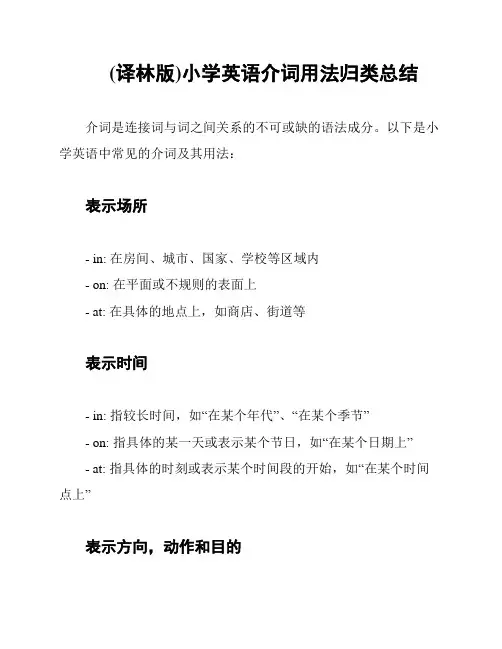
(译林版)小学英语介词用法归类总结
介词是连接词与词之间关系的不可或缺的语法成分。
以下是小学英语中常见的介词及其用法:
表示场所
- in: 在房间、城市、国家、学校等区域内
- on: 在平面或不规则的表面上
- at: 在具体的地点上,如商店、街道等
表示时间
- in: 指较长时间,如“在某个年代”、“在某个季节”
- on: 指具体的某一天或表示某个节日,如“在某个日期上”
- at: 指具体的时刻或表示某个时间段的开始,如“在某个时间点上”
表示方向,动作和目的
- to: 表示动作的结果或目的地
- from: 表示某个地方开始出发
- through: 表示穿过某个物体或在某个时间段表达的过程中
- across: 表示横跨一个区域或表达某种对比
- over: 表示越过某个物体,如桥、障碍等
表示对象,原因和依据
- about: 关于某个话题
- for: 表示名词的目的或代替目的的代词
- because of: 表示某个事件或原因,如“因为雨”
- with: 表示伴随或某种工具
- by: 表示某种方式或依据,如“通过手写”
介词是较为抽象的词汇,对于英语学习者来说需要多做题来记忆和掌握其使用方法。
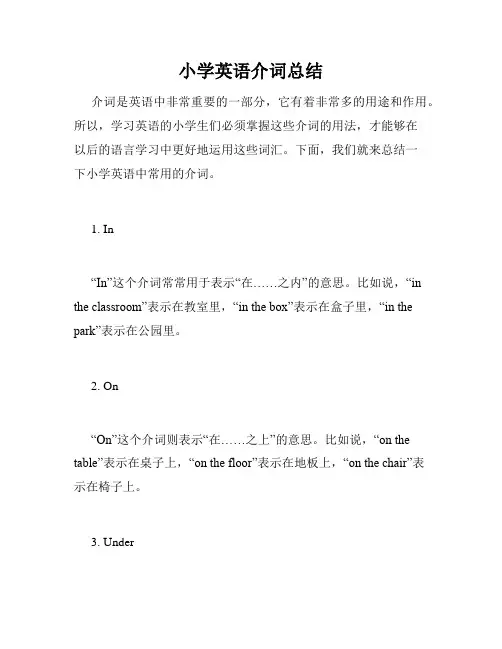
小学英语介词总结介词是英语中非常重要的一部分,它有着非常多的用途和作用。
所以,学习英语的小学生们必须掌握这些介词的用法,才能够在以后的语言学习中更好地运用这些词汇。
下面,我们就来总结一下小学英语中常用的介词。
1. In“In”这个介词常常用于表示“在……之内”的意思。
比如说,“in the classroom”表示在教室里,“in the box”表示在盒子里,“in the park”表示在公园里。
2. On“On”这个介词则表示“在……之上”的意思。
比如说,“on the table”表示在桌子上,“on the floor”表示在地板上,“on the chair”表示在椅子上。
3. Under“Under”这个介词则是表示“在……下面”的意思。
比如说,“under the bed”表示在床底下,“under the tree”表示在树下,“under the desk”表示在桌子下面。
4. Beside“Beside”这个介词则是表示“在……旁边”的意思。
比如说,“beside the window”表示在窗户旁边,“beside the door”表示在门旁边,“beside the road”表示在路边。
5. Behind“Behind”这个介词则表示“在……后面”的意思。
比如说,“behind the building”表示在建筑物后面,“behind the chair”表示在椅子后面,“behind the tree”表示在树后面。
6. Above“Above”这个介词则表示“在……上面”的意思。
比如说,“above the clouds”表示在云层之上,“above the sky”表示在天空之上,“above the mountain”表示在山顶之上。
7. Below“Below”这个介词则表示“在……下面”的意思。
比如说,“below the sea”表示在海底,“below the ground”表示在地底,“below the surface”表示在表面之下。
小学三年级英语介词表(带英标)一、基础介词1. at - 在某个地方 (e.g. at the park - 在公园)2. on - 在某个物体上 (e.g. on the table - 在桌子上)3. in - 在某个区域内 (e.g. in the classroom - 在教室里)4. under - 在某物下方 (e.g. under the bed - 在床下)二、方位介词1. in front of - 在...前面 (e.g. in front of the house - 在房子前面)2. behind - 在...后面 (e.g. behind the tree - 在树后面)3. next to - 在...旁边 (e.g. next to the car - 在车旁边)4. between - 在...之间 (e.g. between the two chairs - 在两把椅子之间)三、时间介词1. at - 在...时候 (e.g. at 8 o'clock - 在8点钟)2. on - 在某一天 (e.g. on Monday - 在星期一)3. in - 在某个时间段内 (e.g. in the morning - 在早上)4. during - 在...期间 (e.g. during the summer vacation - 在暑假期间)四、目的介词1. for - 为了某目的 (e.g. for studying - 为了研究)2. to - 去某地 (e.g. to the supermarket - 去超市)3. with - 和某人/物在一起 (e.g. with my friend - 和我的朋友在一起)4. by - 通过某种方式 (e.g. by bus - 乘公共汽车)五、方式介词1. by - 用某种方式 (e.g. by bike - 用自行车)2. with - 用某物 (e.g. with a pen - 用一支笔)3. like - 像...一样 (e.g. run like the wind - 像风一样奔跑)4. as - 作为某个身份/角色 (e.g. as a student - 作为一个学生)六、动态介词1. to - 去做某事 (e.g. go to school - 去上学)2. for - 为了做某事 (e.g. study for the test - 为了考试而研究)3. about - 关于某事 (e.g. talk about the movie - 谈论电影)4. with - 用某物做某事 (e.g. write with a pen - 用笔写)七、表示关系介词1. of - ...的 (e.g. the book of the teacher - 老师的书)2. to - ...的 (e.g. the key to the door - 门的钥匙)3. with - 与...一起 (e.g. the girl with the dog - 带着狗的女孩)4. from - 来自... (e.g. the present from my friend - 来自我的朋友的礼物)八、其他常用介词1. about - 关于 (e.g. a book about animals - 一本关于动物的书)2. to - 向 (e.g. go to bed - 去睡觉)3. by - 通过 (e.g. send a message by email - 通过电子邮件发送消息)4. with - 用 (e.g. cut with scissors - 用剪刀剪)以上是小学三年级英语介词表,带有英文标识,方便学生记忆和理解。
小学英语常考介词介词一般置于名词之前,它常和名词或名词性词语构成介词短语。
同一个介词和不同的词语搭配形成固定搭配,表示不同的意义。
一、常考时间介词at,on,in时间介词at,on,in后面都可以接表示时间的词,但用法又有所不同。
1、时间介词at的用法:(1)at+具体时刻/时间点。
如:at six o'clock ;at a quarter to eight ;at half past nine(2)at+某个时段。
如:at noon/night ;at weekends(3)at+节日。
如:at Christmas(4)at+年龄。
如:at ten/at the age of ten例:Peter usually gets up at 7 o'clock in the morning.PeterThe clock strikes twelve times at noon.We'll see you at Christmas.She left her hometown at fourteen.(1)on+星期。
如:on Monday ;on Friday(2)on+具体日期。
如:on May 21st(3)on+具体某天的上午/下午/晚上。
如:on Saturday evening on the morning of May 21st例:We have an English class on Thursday.Mike's birthday is on March 9th.They will have a football game on the afternoon of April 11th.3、时间介词in的用法:(1)in+上午/下午/晚上。
如:in the morning/afternoon/evening(2)in+月份、季节、年份。
如:in October ;in spring ;in 2015(3)in+年龄。
英语中的介词早、午、晚要用in,at黎明、午夜、点与分。
年、月、年月、季节、周,阳光、灯、影、衣、冒in。
将来时态in...以后,小处at大处in。
有形with无形by,语言、单位、材料in。
特征、方面与方式,心情成语惯用in。
介词at和to表方向,攻击、位置、恶、善分。
日子、日期、年月日,星期加上早、午、晚,收音、农场、值日on,关于、基础、靠、著论。
着、罢、出售、偷、公、假,故意、支付、相反,准。
特定时日和“一……就”,on后常接动名词。
年、月、日加早、午、晚,of之前on代in。
步行、驴、马、玩笑on,cab,carriage则用in。
at山脚、门口、在当前,速、温、日落、价、核心。
工具、和、同随with,具有、独立、就、原因。
就……来说宾译主,对、有、方状、表细分。
海、陆、空、车、偶、被by,单数、人类know to man。
this、that、tomorrow,yesterday,next、last、one。
接年、月、季、星期、周,介词省略已习惯。
over、under正上下,above、below则不然,若与数量词连用,混合使用亦无关。
’beyond超出、无、不能,against靠着,对与反。
besides,except分内外,among之内along沿。
同类比较except,加for异类记心间。
原状because of,、owing to、due to表语形容词under后接修、建中,of、from物、化分。
before、after表一点,ago、later表一段。
before能接完成时,ago过去极有限。
since以来during间,since时态多变换。
与之相比beside,除了last but one。
复不定for、找、价、原,对、给、段、去、为、作、赞。
快到、对、向towards,工、学、军、城、北、上、南。
but for否定用虚拟,复合介词待后言。
ing型由于鉴,除了除外与包合。
小学英语知识归纳总结:介词一、定义介词preposition缩写prep.,又叫前置词,表示其后的名词或代词(或是相当于名词的其他短语或从句)与其他句子成分的关系。
介词是一种虚词,不能单独在句中作成分。
二、介词的用法1、表示时间的(at 、on、in、at、before ,after、by、until、through、from、since、within)(1)at:用于表示时刻,时间的某一点。
at noon在午时at night在夜间at present目前(2)on:用于星期,某天,某一天的上午、下午、晚上(指具体的某一天时,一律用on) 如:on sunday在星期天on sunday morning 在星期天的上午 on march 8 在3月8日(3)in:用于表示周、月、季节、年、泛指上午、下午、晚上。
in 1999 在1999年in november 在11月份in summer 在夏季in the afternoon在下午过……后(未来时间)I think he will be back in an hour .我想他一小时后就会回来。
I heard that she would be back in a month.我听说她一个月后回来的。
(4)before:在……之前Wei hua got up before 7 o’clock this morning .今天早晨,魏华在7点之前起床了。
(5)after:在……之后Aafter that ,no noe should ever kill a seagull . 从那时起,任何人不得捕杀海鸥。
(6)by:在……前(时间),截止(到)……By the time i arrived ,she had already gone .在我到达之前,她已经走了。
(7)for:达……之久(表示过了多少时间),可以和一般现在时,过去时,将来时连用,但是经常和完成时连用。
小学英语三至五年级介词表什么是介词介词是连接词,常用来连接名词和名词、名词和动词、名词和形容词等,表示时间、地点、方式、原因、目的等。
常见介词- at 在……的时候或地点,例如:at home(在家里)、at school(在学校)、at night(在晚上)at在……的时候或地点,例如:at home(在家里)、at school(在学校)、at night(在晚上)- in 表示在……之内,例如:in the box(在盒子里)、in the room(在房间里)、in the morning(在早上)in表示在……之内,例如:in the box(在盒子里)、in the room(在房间里)、in the morning(在早上)- on 表示在……之上,例如:on the table(在桌子上)、on the bed(在床上)、on Sunday(在星期天)on表示在……之上,例如:on the table(在桌子上)、on the bed(在床上)、on Sunday(在星期天)- to 表示方向和目的地,例如:go to school(去学校)、give something to someone(把东西给某人)to表示方向和目的地,例如:go to school(去学校)、give something to someone(把东西给某人)- with 表示伴随,例如:play with friends(和朋友一起玩)、walk with a dog(和一只狗一起散步)with表示伴随,例如:play with friends(和朋友一起玩)、walk with a dog(和一只狗一起散步)- without 表示没有,例如:go without me(没有带我去)、eat without vegetables(没有吃蔬菜)without表示没有,例如:go without me(没有带我去)、eat without vegetables(没有吃蔬菜)- for 表示目的,例如:buy a gift for my mom(为我妈妈买礼物)for表示目的,例如:buy a gift for my mom(为我妈妈买礼物)- of 表示从属,例如:a picture of my family(一幅我家庭的照片)、the color of the sky(天空的颜色)of表示从属,例如:a picture of my family(一幅我家庭的照片)、the color of the sky(天空的颜色)希望这份介词表能够帮助到小学三至五年级的同学们。
小学英语介词总结介词(Preposition)一、概述介词是英语中很活跃的词,一般置于名词之前。
它常和名词或名词性词语构成介词短语。
同一个介词常和不同的词语搭配形成固定搭配,表示不同意义。
二、常用介词的基本用法简单介词(由一个单词构成)如at, from, by, under, near等。
复合介词(由介词与介词或其他词合成的一个介词)into, inside, outside,within等。
双重介词(由两个简单介词联合形成)如from across, since before等。
短语介词(由两个或两个以上构成的介词词组)如because of , instead of等。
1. 表示地点位置的介词1)at ,in, on, to,forat (1)表示在小地方; (2)表示“在,,附近,旁边”in (1)表示在大地方; (2)表示“在,范围之内”。
on表示毗邻,接壤,“在,,上面”。
to 表示在 ,, 范围外,不强调是否接壤;或“到,, ”2)above, over, on在,,上above 指在 ,, 上方, 不强调是否垂直,与below 相对;The bird is flying above my head.over 指垂直的上方 , 与 under 相对 , 但 over 与物体有一定的空间,不直接接触。
There is a bridge over the river.on 表示某物体上面并与之接触。
He put his watch on the desk.3)below, under 在,,下面under 表示在 , 正下方There is a cat under the table.below 表示在 ,, 下,不一定在正下方Please write your name below the line.4)in front of, in the front of在,, 前面in front of, 意思是“在 ,, 前面”,指甲物在乙物之前,两者互不包括;其反义词是 behind (在 ,, 的后面)。
There are some flowers in front of the house.(房子前面有些花卉。
)in the front of意思是“在, ..的前部”,即甲物在乙物的内部. 反义词是 at the back of, (在 ,, 范围内的后部)。
There is a blackboard in thefront of our classroom.我们的教室前边有一块黑板。
Our teacher stands in the front of the classroom.我们的老师站在教室前 .( 老师在教室里 )5)beside , behindbeside表示在 ,, 旁边behind表示在 ,, 后面2.表示时间的介词1)in , on,at在,,时in 表示较长时间,如世纪、朝代、时代、年、季节、月及一般(非特指)的早、中、晚等。
如 in the 20th century, in the 1950s, in 1989, in summer, inJanuary, in the morning, in one’s life , in one’s thirties等。
on 表示具体某一天及其早、中、晚。
如 on May 1st, on Monday, on Christmas ,on NewYear’s Day, on a cold night in January,on a fine morning, on Sunday afternoon等。
at 表示某一时刻或较短暂的时间,或泛指圣诞节,复活节等。
如 at 3:20,at this time of year, at the beginning of, at the end of, , at the ageof , , at night, at noon, at this moment等。
注意:在 last, next, this, that, some, every等词之前一律不用介词。
如: We meet every day.2)表示延续时间的介词“ in + 段时间”表示将来的一段时间以后;He will be back in two hours.for历时 ...之久Lisa studies English for two hours after school.since 自从 .......以来,通常与完成时连用They have been close friendssince childhood.时间名词前介词用法口诀年前月前要用 in具体日子要用on遇到几号也用 on上午下午得是in要说某日上下午用on换in记清楚午夜黄昏用at黎明用它也不错at用在时分前说“差”可要用上to( 比如: 3:55 为 five to four)说"过''要用past(如:4:05,five past four)3.表示运动方向的介词:across, through通过,穿过across 表示横过 , 即从物体表面通过 across the roadthrough 穿过 , 即从物体内部穿过 go through the forest4.表示“在 ,, 之间”的介词: between 指在两个人或两个事物之间; among 指在三个或三个以上的人或事物之间。
5.表示其他意义的介词1)on ,about关于on 表示这本书,这篇文章或演说是严肃的,或学术性的,可供专门研究这一问题的人阅读; He is writing a book on biology.about 表示内容较为普通,不那么正式。
He is reading a book about English.2)by, with, in表示方法、手段、工具by 以,, 方法、手段或泛指某种交通工具;by buswith 表示用 , 工具、手段,一般接具体的工具和手段;He writes with a pen. in 表示用 , 方式,用, 语言 ( 语调、笔墨、颜色 ) 等;Can you say it in English?I go to school in my father's car.3)except, besides除了except除,, 之外,不包括在内;Except for Mr. Wang, we went to see the film.(王先生没去 )besides除,, 之外,包括在内。
Besides Mr. Wang, we also went to see the film.(王先生也去了 )三、介词的固定搭配1)介词和名词的连用 2) 动词和介词的连用at arrive at/in到达at first起初;开始 get off 下车at last最后 help sb. With sth.帮组某人做某事at school在上课,在上学 ask for 请求at the moment此刻 get up 起床at home 在家;无拘束 laugh at嘲笑at present 现在 learn from 向,, 学习at work上班,在工作 look after照顾at the same time 同时 look for寻找think for想到worry about担心on duty值日 listen to听谁on holiday 度假 look at看;注视on time准时 talk about交谈;谈on the left/right在左 / 右边 wait for等候;等on the radio在广播中 thank for为,,而感谢on foot步行on sale出售;降价出售3) 形容词和介词连用on TV 在电视上播放 be afraid of害怕on the phone 在电话中 be careful with小心;关心on the way在路上 be interested in对,, 感兴趣be good at善于in all总体 be crazy about 酷爱in class在课堂上 be late for做某事迟到in English用英语 be good for对,, 有利in short总之 4)其他in a hurry匆忙地 by+交通工具in the end最后 by bus/train/plane/air/ship/bike/sea/land, in bed躺在床上 lots of/a lot of许多,大量in danger在危险中 at most 至多in fact事实上 at least至少in time及时地 at once立刻;马上in a minute立刻 in order to为了初中英语介词专项练习题1( ) 1 Children get gifts ____ Christmas and ____ their birthdays.A. on; onB. at; onC. in; inD. in; on( ) 2 -There is nothing ____tomorrow afternoon, is there?-No. We can have a game of table tennis.A. onB. inC. outD. up( ) 3 A lot of students in our school were born____March, 1981.A. inB. atC. onD. since( ) 4 Tim suddenly returned____ a rainy night.A. onB. atC. inD. during( ) 5 My grandfather was born____Oct. 10, 1935.A. onB. inC. atD. of( ) 6 The train is starting___five minutes.A. inB. atC. forD.still( ) 7 Mike does his exercises ____ seven _____ the evening.A. on; toB. at; inC. by; ofD. at; on2( ) 1 The population of the world has grown very fast ____ four hundred years.A. for past theB. in the passC. in the pastD. forpast ( ) 2 We returned to our hometown___.A. next weekB. in the last weekC. last weekD. for aweek 3( ) 1 Children wake up very early____the morning of Christmas Day.A. inB. onC. forD. at( ) 2 ____ a cold winter morning, I met her in the street.A. InB. OnC. AtD. For( ) 3 It happened to be very cold____ the morning of our sports meeting.A. atB. onC. withD. of( ) 4 Why did you get up so early ___ this morning.A. onB. /C. atD. in4( ) 1 He went to Shanghai___ September 3rd, 1991 and came back___ a cold morning last year.A. in; onB. on; inC. on; onD. in; ia( ) 2 Lucy was born____ the night of May 12, 1984. . ...A. onB. inC. atD. to( ) 3 Mrs Brown came to China ____ 1996.A.onB. ofC. to,D. in( ) 4 ___ the morning of November 20, 1915, the workers came to Chicagoto show their mourning(哀悼 )___Joe Hill.A. On; toB. In; of .C. On; for ,D. At; for( ) 5Ann moved___Hangzhou___September, 1992.A. /; in iB. to; inC. to; on D, in; in( ) 6They started off___an autumn afternoon.A. duringB. atC. inD. on5( ) 1He often goes ____ school ____ six thirty ____ the morning.A. for; to; inB. to; at inC. to; for; at D, for; at; to( ) 2 He arrived ___ Shanghai ___ 9: 30 ___ March 5.A. at; in; atB. to; on; atC. in; on; atD. in; at; on( ) 3 The English teacher told me to get there____ half past ten.A: in B. at C. on D. of( ) 4 The children get up ___ 6 o'clock.A. atB. onC. duringD. in6( ) 1 The doctor worked___ five hours___ a rest.A. for; withB. on; withoutC. about; havingD. for; without( ) 2 I worked on the problem____ a long time and I worked it out____myself____ last.A. for; by; atB. in; with; onC. on; by; inD. for; for; at the( ) 3 A new factory will be set up___ a year.A. forB. inC. afterD. on( ) 4 Two years___ he began to write another story-book.A. afterB. later ;C. inD. late( ) 5 We will finish the picture ____ a day.A. inB. onC. afterD. on( ) 6 The workers had been____ strike____almost a month.A. on; inB. at; inC. on; forD. on; during( ) 7 Mr Brown had lain____ the ground ____ four hours before they finally found him.A. on; forB. at; inC. on; afterD. in; during7( ) 1 The teacher is coming back___ an hour.A. afterB. forC. inD. before( ) 2 She lived in the mountain village____ the years 1940-1950.A. betweenB. duringC. inD. since( ) 3 Miss Wang will come to Beijing____ two days.A. afterB. inC. onD. before( ) 4 The American Civil War lasted four years before the North won____ the end.A. byB. atC. inD. on8( ) 7 Mary had finished her homework____ the time I got home.A. untilB. byC. atD. when( ) 2 We stayed at the lab___ our teacher returned.A. tillB. byC. duringD. while91 Don't worry. He will return____.A. before longB. long beforeC. long long agoD. longago 2 There lived an old man, fishing at sea____.A. long beforeB. before longC. long time agoD. soon3 It was not _____ they came back.A. long beforeB. before longC. long time beforeD. long after4 I was told that his uncle had gone to France____ .A. long before -B. shortly afterC. before longD. long ago10( ) 1 ___ Tom gets up at five in the morning.A. SometimeB. SometimesC. Some timeD. Some times( ) 2 I remember we met each other___ last year.A. SometimeB. some timesC. some timeD. sometimes( ) 3 Mary and I have been to the Great Wall,___.A. sometimeB. some timeC. sometimesD. some times( ) 4 He studied English for ____ in London, and then he went to America.A. sometimesB. sometime newB. some time B. some times11( ) 1 I don't like to sit ___ Tom's right. I would like to sit ___ theback row.A. on; inB. in; onC. on; atD. at; on( ) 2 There is a brook____ red flowers and green grass___ both sides.A. of withB. with; onC. of; atD. with; in( ) 3 There are many trees ___ of the road! And ____ of the trees isgrowing larger and larger. ......A. on both side; a numberB. on each sides; a numberC. on both sides; the numberD. on every side; the number12( ) 1 The plane is flying _____.A. in the skyB. in. the airC. in spaceD. in sky( ) 2 There is a sweet smell___.A. in the airB. in the open airC. in the skyD. in the space( ) 3 We held an interesting party___.A. in the airB. in the skyC. in the open airD. in space( ) 4 Seen from___, the earth appears to be a big blue ball.A. the spaceB. spaceC. a spaceD. this space13( ) 1 Tom sits____the classroom while John sits____the room.A. in front of; at back ofB. in the front of; at the back ofC. in front of; at the back ofD. in the front of; at back of( ) 2 Lucy sits____ the third row, ____Jim's left.A. on; onB. in; atC. at; inD. in; on( ) 3 Jiangsu is___ the east of China, but Japan is ___ the east of China.A. to; inB. in; to .C. on; toD. to; on14( ) 1. -Can I look up a word____ your dictionary?-I haven't got it ____me.A. into; aboutB. in; withC. at; inD. on; on( ) 2 I like mooncakes ____ meat ____ them.A. in; onB. with; onC. in; theD. with; in( ) 3 When you are ___ trouble please ask help ___ us.A. in; fromB. in; forC. on; fromD. on; of( ) 4 The shopkeeper said they had sold out the shoes____ your size.A. aboutB. inC. toD. of( ) 5 I saw him___hurry just now.A. in aB. inC. onD. on a15( ) 1 He put up a map ___ the back wall because there was a hole ___ it.A. on; onB. at; inC. on; inD. on; at( ) 2 There is a door___ the wall.A. onB. toC. ofD.in( ) 3 This kind of VCD is made____ China. .A. inB. fromC. atD. on( ) 4 Any man ___ eyes______ his head can see that he's exactly like a rope.A. with; onB. with; inC. on; withD. in; with16( ) 1 There are some birds singing___ the trees.A. inB. onC. atD. from( ) 2 Don't read ____ the sun. It's bad ___ your eyes.A. in; toB. under; forC. with; toD. in; on( ) 3 The woman____ a blue dress is my teacher.A. inB. onC. ofD. at( ) 4 There are so many apples___ that tree.A. in B, on C. at , D. from17( ) 1 The boat is passing___ the bridge.A. throughB. belowC. underD. across( ) 2 Two planes are flying___ the city.A. throughB. over ,C. on , D, below( ) 3 We can see a river running to the east____ the hill.A. underB. belowC. overD. on( ) 4 Do you see the kite ___ the building.A. overB. crossC. onD. above18( ) 1 The United States is ____ the south of Canada and ___ the east of Japan.A. to; inB.on;toC. in; besideD. at; on( ) 2 My hometown lies___ the city. ___ I often go to the city by bike. A. 50 miles in the east; However B. to the east 40 miles of; ButC. in the east 45 miles from; ButD. 35 miles east of; However( ) 3 The man stood____the window, watching the boys playing outside.A. inB. byC. withD. to( ) 4 Japan lies____ the east of China.A. on Bto C. in D. with19( ) 1 Is the street too narrow for the bus to go ___?A. throughB. acrossC. onD. in( ) 2 A mother camel was walking ___ her son ___ the desert.A. without; alongB. with; throughC. next to; passD. beside; through( ) 3 The river runs____ the city.A. acrossB. throughC. overD. from( ) 4 It took us over an hour to walk____ this street.A. fromB. throughC. overD. across20( ) 1 Uncle Wang arrived____ No. 14 Middle School half an hour ago.A. atB. inC., to ^D. /( ) 2 Did your friend send you something ___ the end of last week?A. atB. byC. inD. to( ) 3 The monument____ those heroes stands____the foot of the mountain.A. of; atB. to; onC. for; byD. to; at( ) 4 My uncle lives ____ 88 Beijing Street.A. toB. ofC. atD. on( ) 5 They are waiting ___ a bus ___ the bus stop.A. for; inB. on; atC. with; atD. for; at21( ) 1 Wood is often made___paper.A. byB. fromC. ofD. intohave put a lot of ( ) 2 ___ research ___ the universe scientistsinformation ___ computers.A. With; over; atB." On; at; toC. In; about; intoD. For; with; through( ) 3; When a piece of ice is taken ____ a warm room, it gets smallerand smaller until ___ the end it disappears completely.A. in; inB. out of; atC. into; inD. to; by( ) 4 A woman fell ___ the boat ___ the water.A. off; intoB. at; belowC. down; underD. away; in22( ) 1 The tables in the restaurant are so close together that there'shardly any room to move___them.A. amongB. betweenC. in the middle ofD. at the centre of( ) 2 English is widely used for business____ different countries.A. betweenB. toC. forD. on( ) 3 Is there any difference ____ these two sentences?A. forB. inC. amongD. between( ) 4 We visited him at his workplace ___ the young trees and askhim about his work. EA. inB. amongC. betweenD. at( ) 5 There is the difference___ Chinese food and American food.A. fromB. atC. betweenD. by( ) 6 The police station is ___ the clothing shop ___ the post office.A. between; andB. among; andC. near; ofD. on; right( ) 7 He is ____ the greatest scientists in the world.A. amongB. betweenC. inD. of23( ) 1 There is a book-store ___ our house.A. atB. throughC. acrossD. near( ) 2 Our headmaster showed the visitors ____ our school.A. toB. forC. around -;D. near( ) 3 The moon is the ___ to the earth.A. closedB. nearC. nearestD. close24( ) 1 We have classes every day ____ Sunday.A. besideB. besidesC. exceptD. except for( ) 2 Nobody knew it ____ me.A. butB. besideC. besidesD. without( ) 3 What do you spend your time on ___ work and study?A. exceptB. besidesC. butD. without( ) 4 Do you know any other foreign language____ English.A. withoutB. besideC. besidesD. except( ) 5 We need fifteen more people ____ the twenty of us to do the job.A. besidesB. andC. exceptD. without( ) 6 No one knew where Mr Smith lived____ his daughter.A. besidesB. and C, only D. except25( ) 1 _____ the help of the teacher, Tom has made rapid progress ____hisstudies.A. For; atB. Of; forC. By; onD. With; in( ) 2 The children are interested___this subject.A. toB. withC. inD. at( ) 3 His mother often helps him ___ English so he does better ___ English than others. ;A. with; inB. on; inC. in; withD. with; at( ) 4 I've lost my interest____physics.A. inB. onC. atD. for( ) 5 He drove away___the direction of London.A. inB. atC. toD. for( ) 6 The letter was written ___ ink.A. withB. inC. byD. at26( ) 1 ___ the money, she bought a new coat ___ her father.A. With; forB. With; toC. For; withD. To; with( ) 2 Wei Hua gets on well ___ her classmates.A. withB. inC. toD. at( ) 3 There is something wrong___my bike.A. atB. inC. onD. with( ) 4 They are filling their bags____ books and other things.A. inB. withC. ofD. by( ) 5 When the teacher heard us talking in class, he was very angry ____ A. to B. with C. for D. of( ) 6 We usually cover the Christmas trees ____ colour lights.A. inB. useC. forD. with27( ) 1 -His sudden death surprised his wife.-It was so bad. His wife was surprised ____ his death.A. byB. withC.atD. on( ) 2 Don't laugh____ him, he only made a small mistake.A. atB. toC. aboutD. over( ) 3 The boy cried out ___ the top of his voice.A. atB. inC. onD. to28( ) T We Chinese people are all___ our motherland .A. famous forB. proud ofC. busy withD. good at( ) 2 The beautiful bottle was made ____ glass.A. fromB. inC. ofD. by( ) 3 This is a map___China.A. inB. atC. ofD. on( ) 4 A group___ boys and girls are dancing in the park.A. withB. ofC. forD. to29( ) 1 They are getting ready____ fly____ England____their holiday. A. for; to; to B. to; to; for C. for; for; to D. to; to; to( ) 2 What did you have ___ breakfast?A. atB. asC. forD. about( ) 3 They were invited to an important ball ____ the first time ____ their lives.A. for; inB. at; inC. on; forD. in; with( ) 4 Tom always comes late____school.A. at .B. insideC. toD. for( ) 5 Mr Smith caught hold___ Bob and said, "This is a good lesson___ you.A. of; forB. for; ofC. of; ofD. for; for( ) 6 The shop___ clothes is the right side ___ the street.A. of; at; besideB. for; on; atC. for; on; ofD. of; in; of初中英语介词专项练习题1( ) 1 Children get gifts ____ Christmas and ____ their birthdays.A. on; onB. at; onC. in; inD. in; on( ) 2 -There is nothing ____tomorrow afternoon, is there?-No. We can have a game of table tennis.A. onB. inC. outD. up( ) 3 A lot of students in our school were born____March, 1981.A. inB. atC. onD. since( ) 4 Tim suddenly returned____ a rainy night.A. onB. atC. inD. during( ) 5 My grandfather was born____Oct. 10, 1935.A. onB. inC. atD. of( ) 6 The train is starting___five minutes.A. inB. atC. forD.still( ) 7 Mike does his exercises ____ seven _____ the evening.A. on; toB. at; inC. by; ofD. at; on2( ) 1 The population of the world has grown very fast ____ four hundred years.A. for past theB. in the passC. in the pastD. for past( ) 2 We returned to our hometown___.A. next weekB. in the last weekC. last weekD. for a week( ) 3 Great changes have taken place___.A. in the last few yearB. in the last few yearsC. last yearD. on the last year3( ) 1 Children wake up very early____the morning of Christmas Day.A. inB. onC. forD. at( ) 2 ____ a cold winter morning, I met her in the stfeet.A. InB. OnC. AtD. For( ) 3 It happened to be very cold____ the morning of our sports meet.A. atB. onC. withD. of( ) 4 Why did you get up so early ___ this morning.A. onB. /C. atD. in4( ) 1 He went to Shanghai___ September 3, 1991 and came back___ a cold morning last year.A. in; onB. on; inC. on; onD. in; ia( ) 2 Lucy was born____ the night of May 12, 1984. . ...A. onB. inC. atD. to( ) 3 Mrs Brown came to China ____ 1996.2.on B. of C. to, D. in( ) 4 ___ the morning of November 20, 1915, the workers came to Chicago to show their mourning___Joe Hill.A. On; toB. In; of .C. On; for ,D. At; for( ) 5 Ann moved___Hangzhou___September, 1992.A. /; in iB. to; inC. to; on D, in; in( ) 6 They started off___an autumn afternoon.A. duringB. atC. inD. on5( ) 1 He often goes ____ school ____ six thirty ____ the morning.A. for; to; inB. to; at inC. to; for; at D, for; at; to( ) 2 He arrived ___ Shanghai ___ 9: 30 ___ March 5. fA. at; in; atB. to; on; atC. in; on; atD. in; at; on( ) 3 The English teacher told me to get there____ half past ten.A: in B. at C. on D. of( ) 4 The children get up ___ 6 o'clock.A. atB. onC. duringD. in6( ) 1 The doctor worked___ five hours___ a rest.A. for; withB. on; withoutC. about; havingD. for; without( ) 2 I worked on the problem ____ a long time and I worked it out____myself____ last.A. for; by; atB. in; with; onC. on; by; inD. for; for; at the( ) 3 A new factory will be set up:___ a year. ^'lotaeA. forB. inC. afterD. on( ) 4 Two years___ he began to write another story-book.A. afterB. later ;C. inD. late( ) 5 We will finish the picture a day.A. inB. onC. afterD. on( ) 6 The workers had been____ strike____almost a month.A. on; inB. at; inC. on; forD. on; during( ) 7 Mr Brown had lain ____ the ground ____ four hours before they finally found him.A. on; forB. at; inC. on; afterD. in; during7( ) 1 The teacher is coming back___ an hour.A. afterB. forC. inD. before( ) 2 She lived in the mountain village____ the years 1940-1950.A. betweenB. duringC. inD. since( ) 3 Miss Wang will come to Beijing____ two days.A. afterB. inC. onD. before( ) 4 The American Civil War lasted four years before the North won ____ the end.A. byB. atC. inD. on8( ) 7 Mary had finished her homework____ the time I got home.A. untilB. byC. atD. when( ) 2 We stayed at the lab___ our teacher returned.A. tillB. byC. duringD. while( )3 They didn't leave the station___ they get on the train.A. untilB. byC. after yD. at91 Don't worry. He will return____.A. before longB. long beforeC. long long agoD. long ago2 There lived an old man, fishing at sea____.A. long beforeB. before longC. long time agoD. soon3 It was not _____ they came back.A. long beforeB. before longC. long time beforeD. long after4 I was told that his uncle had gone to France .A. long before -B. shortly afterC. before longD. long ago10( ) 1 ___ Tom gets up at five in the morning.A. SometimeB. SometimesC. Some timeD. Some times( ) 2 I remember we met each other___ last year.A. Sometime'B. some timesC. some timeD. sometimes( ) 3 Mary and I have been to the Great Wall,___.A. sometimeB. some timeC. sometimesD. some times( ) 4 He studied English for ____ in London, and then he went to America.A. sometimesB. sometime newB. some time B. some times11( ) 1 I don't like to sit ___ Tom's right. I would like to sit ___ the back row.A. on; inB. in; onC. on; atD. at; on( ) 2 There is a brook____ red flowers and green grass___ both sides. A. of with B. with; on C. of; at D. with; in( ) 3 There are many trees ___ of the road! And ____ of the trees isgrowing larger and larger. ......A. on both side; a numberB. on each sides; a numberC. on both sides; the numberD. on every side; the number12( ) 1 The plane is flying _____.A. in the skyB. in. the airC. in spaceD. in sky( ) 2 There is a sweet smell___.A. in the airB. in the open airC. in the skyD. in the space( ) 3 We held an interesting party___.A. in the airB. in the skyC. in the open airD. in space( ) 4 Seen from___, the earth appears to be a big blue ball.A. the spaceB. spaceC. a spaceD. this space13( ) 1 Tom sits____the classroom while John sits____the room.A. in front of; at back ofB. in the front of; at the back ofC. in front of; at the back ofD. in the front of; at back of( ) 2 Lucy sits____ the third row, ____Jim's left.A. on; onB. in; atC. at; inD. in; on( ) 3 Jiangsu is___ the east of China, but Japan is ___ the east of China.A. to; inB. in; to .C. on; toD. to; on14( ) 1. -Can I look up a word____ your dictionary?-I haven't got____me.A. into; aboutB. in; withC. at; inD. on; on( ) 2 1 like mooncakes ____ meat ____ them.A. in; onB. with; onC. in; theD. with; in( ) 3 When you are ___ trouble please ask help ___ us.A. in; fromB. in; forC. on; fromD. on; of( ) 4 The shopkeeper said they had sold out the shoes____ your size.A. aboutB. inC. toD. of( ) 5 I saw him___hurry at the moment.A. in aB. inC. onD. on a15( ) 1 He put up a map ___ the back wall because there was a hole ___ it.A. on; onB. at; inC. on; inD. on; at( ) 2 There is a door___ the wall. "t a ^ncA. onB. toC. ofD.in( ) 3 This kind of VCD is made____ China. .A. inB. fromC. atD. on( ) 4 Any man ___ eyes______ his head can see that he's exactly like a rope.A. with; onB. with; inC. on; withD. in; with16( ) 1 There are some birds singing___ the trees.A. inB. onC. atD. from( ) 2 Don't read ____ the sun. It's bad ___ your eyes.A. in; toB. under; forC. with; toD. in; on( ) 3 The woman____ a blue dress is my teacher.A. inB. onC. ofD. at( ) 4 There are so many apples___ that tree.A. in JB, on C. at , D. from17( ) 1 The boat is passing___ the bridge.A. throughB. belowC. underD. across( ) 2 Two planes are flying___ the city.A. throughB. over ,C. on , D, below( ) 3 We can see a river running to the east____ the hill.A. underB. belowC. overD. on( ) 4 Do you see the kite ___ the building.A. overB. crossC. onD. above18( ) 1 The United States is ____ the south of Canada and ___ the east of Japan.A. to; inB.on;toC. in; besideD. at; on( ) 2 My hometown lies___ the city. ___ I often go to the city by bike.A. 50 miles in the east; HoweverB. to the east 40 miles of; ButC. in the east 45 miles from; ButD. 35 miles east of; However( ) 3 The man stood____the window, watching the boys playing outside.A. inB. byC. withD. to( ) 4 Japan lies____ the east of China.A. on B/ to C. in D. with19( ) 1 Is the street too narrow for the bus to go ___?A. throughB. acrossC. onD. in( ) 2 A mother camel was walking ___ her son ___ the desert.A. without; alongB. with; throughC. next to; passD. beside; through( ) 3 The river runs____ the city.A. acrossB. throughC. overD. from( ) 4 It took us over an hour to walk____ this street.A. fromB. throughC. overD. across20( ) 1 Uncle Wang arrived____ No. 14 Middle School half an hour ago.A. atB. inC., to ^D. /( ) 2 Did your friend send you something ___ the end of last week?A. atB. byC. inD. to( ) 3 The monument____ those heroes stands____the foot of the mountain.A. of; atB. to; onC. for; byD. to; at( ) 4 My uncle lives ____ 88 Beijing Street.A. toB. ofC. atD. on( ) 5 They are waiting ___ a bus ___ the bus stop.A. for; inB. on; atC. with; atD. for; at21( ) 1 Wood is of ten made___paper.A. byB. fromC. ofD. into( ) 2 ___ research ___ the universe scientists have put a lot of information___ computers.A. With; over; atB." On; at; toC. In; about; intoD. For; with; through( ) 3; When a piece of ice is taken ____ a warm room, it gets smaller and smalleruntil ___ the end it disappears completely.。